#ttte north western railway
Explore tagged Tumblr posts
Text
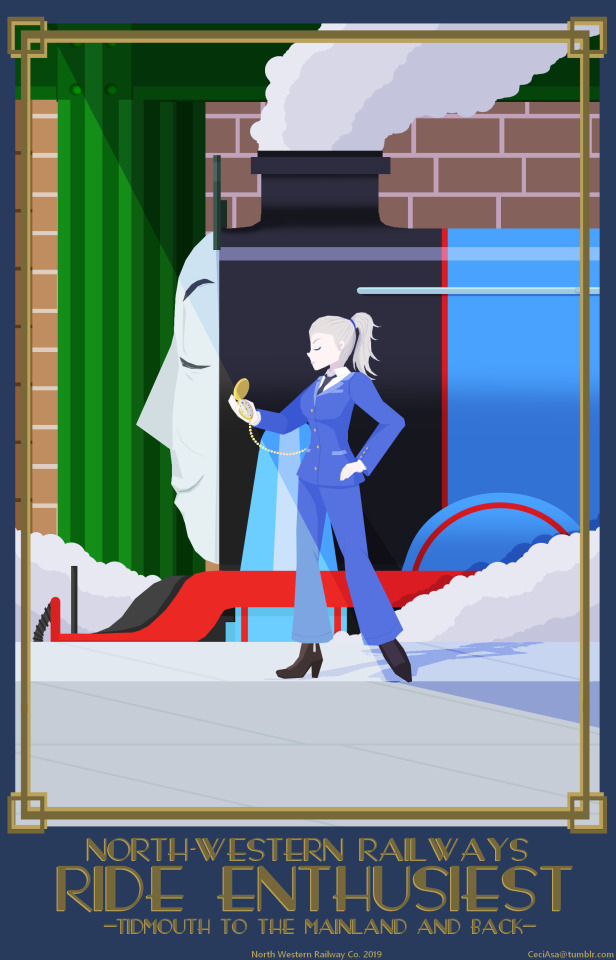
NWR Poster 1 - Enthusiast Run
Young Nor' Westers - Natasha Morozov
#art#ttte fanart#artists on tumblr#digital art#ttte#thomas and friends#ttte human oc#ttte gordon#North Western Railway Poster#art deco#railway poster#railways#the railway series#rws#thomas the tank engine#Young Nor' Westers
430 notes
·
View notes
Text

Swindon Gordon Has been remastered to use the updated LNER A1 Base.
#Hazel's Art#TTTE Gordon#Swindon Gordon#Great North Western AU#Great North Western Railway Au#GWR Palace Class#I'm sending you to Swindon#a fine place for sick engines
21 notes
·
View notes
Text
The Vicarstown Car Ferry

Above: This is not the Vicarstown car ferry train. I just needed a screenshot of a car on a train, and this was the closest I had to hand.
Every year, the Island of Sodor receives thousands of visitors from the Mainland, and obviously, the vast majority come by rail. A significant number, however, choose to arrive by car. Nowadays, this is no trouble, as they can simply drive across the Jubilee Bridge, which carries the main A950 road over the Walney Channel.
The bridge only opened in 1977, though, and any motorists arriving before then had to rely on the NWR's services to get themselves and their cars on and off of Sodor. And thereby hangs a fascinating tale about a little-known aspect of the NWR's history.
EARLY NWR EFFORTS
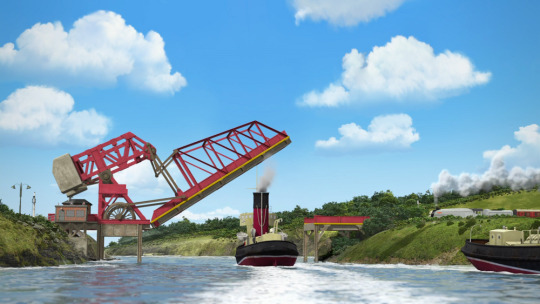
Above: The Vicarstown Bridge, in an undated view (obviously post-1975, given the presence of Spencer).
It all started with the construction of the NWR's own bridge over the Channel in 1915. In those days, there was no other link between Sodor and the Mainland, and thus no other way for goods and passengers to arrive. Some of those passengers wanted to bring their own horse-drawn carriages with them, and so was born one of the earliest vehicle-and-owner trains to run on Sodor. To begin with, it was simply a case of strapping the vehicle to a special carriage truck, and coupling it up to whatever passenger train its owner was travelling in. The truck then travelled as far as the nearest station to wherever the owner was going, where it was detached and the vehicle rolled off.

Above: For a time, the NWR also offered the use of a horsebox in conjunction with a carriage truck, so that the carriage’s owner could take his own horse with him, and avoid having to search for one at the other end of his journey. This cost extra, though, so there were few takers.
THE VICARSTOWN CAR FERRY
With the boom of private motoring in the early-1920s, there came a similar explosion in demand for the carriage of road vehicles by rail. This in turn resulted in the NWR running its first dedicated car-carrying trains - albeit only on an as-and-when basis, and with cars and drivers travelling in separate trains. The NWR did not return to vehicle-and-owner trains until 1927, when it launched a regular car ferry service between Vicarstown and Barrow-in-Furness - probably the best-known of all its car-carrying trains.
This new service had been made possible by the 1925 LMS Agreement, which gave the NWR running powers into Barrow, and in turn required Vicarstown to be converted for through running. Among the changes which resulted was the conversion of the adjoining goods depot to handle parcels and mail (goods facilities moving to a new depot elsewhere), and the closure of the existing parcels platform. This platform was thus free for conversion into a loading dock for the new car ferry service.
OPERATIONS
Throughout the fifty years the car ferry service ran, the basic pattern of its operation remained much the same, with only details like the motive power, rolling stock and timings seeing much change. It is thus worth looking at a typical journey for the service, starting at Vicarstown and ending at Barrow.
Below: A vague representation of how the loading process would have looked. I've employed a bit of artistic license with this photo: while the NWR did have some enclosed double-decker car carriers, these were never used on the car ferry services.

To begin with, the consist for that particular crossing was shunted into the station - the carriage trucks going to the loading dock, and the passenger coaches to one of the through platforms. Drivers and passengers boarded their coaches, leaving their cars to be loaded by the station staff. Once loading was completed, the carriage trucks were marshalled and coupled to the coaches. All shunting was done by the train engine, who then ran round to the front and hauled the train to Barrow. On arrival, the whole train was shunted to the loading dock there, where passengers and cars were unloaded together. The stock was then taken away for servicing. Of course, it goes without saying that in the opposite direction, the whole procedure was repeated, only in reverse.
In all, ten car ferry trains ran daily (five in each direction), with provisions in the working timetable for an extra four (two in each direction) if they were needed - say, during the busier summer months. To avoid overcrowding, a maximum of 20 cars were allowed on each crossing, and motorists had to book in advance. This enabled staff to work out how many carriage trucks were required, and what types, well ahead of time. It also allowed them to work out how many passenger coaches were needed - the rule here was that there should be at least one compartment for every car carried.
In the early 1930s, the NWR began allowing larger commercial vehicles to make use of the car ferry trains, and this required a slight amendment to the 20 cars rule. This amendment counted the size of a vehicle in car lengths - if, for example, a lorry turned up which was as long as three cars, then it took up three slots on that particular crossing. Any number of vehicles could thus travel on a single train, so long as their total length did not exceed 20 car lengths.
STOCK
The car ferry trains never had a specific engine allocated to run them - generally, any engine could do the job if they happened to be at Vicarstown or Barrow at the right time. As the NWR’s locomotive roster expanded, the car ferry became the exclusive preserve of the engines based at either of those sheds - the job generally being allocated to any engine who wasn't busy anywhere else that day.
The car ferry was also a neat way of getting an engine from one station to the other, without having to find an extra path for a light engine movement. For similar reasons, it was not uncommon for visiting LMS (later BR) engines to take charge of a Barrow-bound car ferry on their way home.
Below: An example of a long-wheelbase covered carriage truck. Many were later converted for parcels, newspapers or general goods traffic. This particular example went into departmental service, and in this view is carrying engine parts.

As far as rolling stock was concerned, this mainly consisted of both open and covered carriage trucks (henceforth referred to as OCTs and CCTs respectively). When the service first started, cars were carried on short-wheelbase OCTs, but these proved unpopular with motorists, as the cars often had their paintwork spoiled by smoke and soot spewing from passing engines - and sometimes from the engine pulling the train! The NWR tried to remedy this by offering the use of protective tarpaulins, but eventually they decided it would be more prudent to switch to CCTs instead.
Single cars were carried in short-wheelbase vans, similar in design to the GWR’s Mogo vans.
For pairs of cars, longer wheelbase CCTs could be used.
For trios or quartets, bogie CCTs were employed.
When larger commercial vehicles began to be carried, bogie OCTs were used - converted from the underframes of the fabled Dublin Stock.
Because of the aforementioned one compartment for every vehicle rule, the passenger coaches were at first quite a motley collection, with the numbers being made up by any old stock just lying around. It was only from the 1930s onwards that more consistent rakes of coaches began to be used - starting with Ironclad-pattern stock, moving on to Maunsell-pattern just after the War, and finishing up with Bulleid-pattern in the BR era.
MOTORAIL

Above: A display of Scottish country dancing at...I think it's Kensington Olympia? No, I don't know why either.
In the 1960s, British Rail officially launched its Motorail service, offering fast travel for passengers and their cars to all parts of the country. To serve Sodor, one of the new services ran twice daily between Kensington Olympia and Vicarstown, and the latter’s existing loading dock was upgraded into a terminal. Two of the car ferry's ten daily crossings clashed with the proposed timings of the new Motorail services, and so were slashed from the timetable. Other than that, the car ferry was able to carry on as normal.
By then, the rolling stock used for the car ferry was beginning to show its age, and a programme of gradual replacement was implemented from about 1966 onwards:
For cars, General Utility Vans replaced the old bogie CCTs, which were retained for parcels traffic.
For commercial vehicles, Carflats replaced the OCTs, which were either scrapped or placed into departmental service.
Finally, for passengers, some of the NWR’s own allocation of BR Mk1s replaced the Bulleid-pattern stock.
The car ferry trains continued unabated into the 1970s, but it was clear they were running on borrowed time - for the first time, demand was beginning to outstrip capacity, and there was no room in the timetable to run extra trains. Then, exactly fifty years after the car ferries had first began, came a blow from which they were never to recover.
THE JUBILEE BRIDGE
That year saw the opening of the Walney Road Bridge, to mark the Silver Jubilee of Queen Elizabeth II. Needless to say, this snuffed out the NWR's car ferry monopoly in an instant. Nobody was more incensed at this development than Sir Topham Hatt, and he saw to it that the NWR was substantially compensated for the extinguishment of their ferry rights.

Above: The Jubilee Bridge. Visitors to Barrow (and native Barrovians, too) may think that this is the only bridge here. This is an illusion!
All was not totally lost, however, for 1977 also saw the extension of BR's existing London-Vicarstown Motorail service to a brand new terminal at Killdane - a more convenient base for the visiting motorist to explore Sodor. Such was the success of this new service that further others were introduced, linking Sodor with other provincial centres. Some of these services employed the stock which had previously worked the car ferry trains.
MODERN DAY MOTORAIL
The expansion of Sodor's Motorail services came during a period of gradual decline for the brand across the rest of BR. The expansion of Britain's motorways, the improvement of car technology, and the chaos of privatisation all ultimately conspired to kill off Motorail by the early-1990s.
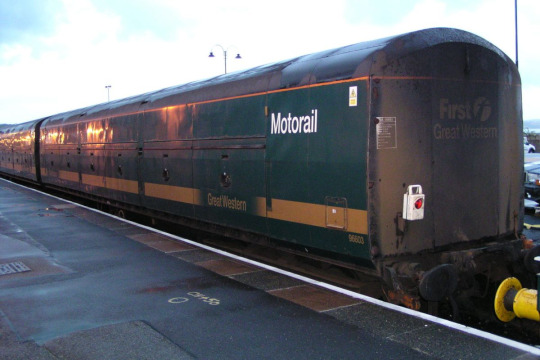
Above: First Great Western briefly revived the Motorail concept in the early-2000s, using a fleet of converted GUVs.
Despite this, Motorail on Sodor has continued to flourish into the present day. Not only are its existing terminals at Vicarstown and Killdane still in operation, but there is now a third terminal at Tidmouth. These form the basis for the NWR's current Motorail services, which all serve to help solve a very basic problem.
The thing is, many visitors to Sodor now arrive in their own cars, but the island's road transport infrastructure isn't really suited to the needs of the long-distance motorist. Fortunately, the NWR has them covered. Special car-carrying trains now run regularly between the Motorail terminals at Vicarstown, Killdane and Tidmouth. While you still have to book in advance, it's a small price to pay for having the convenience of a car at your disposal, without the insanity that comes from having to drive it all the way across Sodor.
Of course, while the NWR's Motorail trains are available to all motorists (local and foreign) the majority of their customers are Mainlanders - the typical Sudrian would just as soon leave his car at home altogether!
#thomas the tank engine#the railway series#sodor#island of sodor#ttte headcanon#ttte analysis#north western railway#vicarstown#vicarstown bridge#barrow in furness#car ferry
50 notes
·
View notes
Text
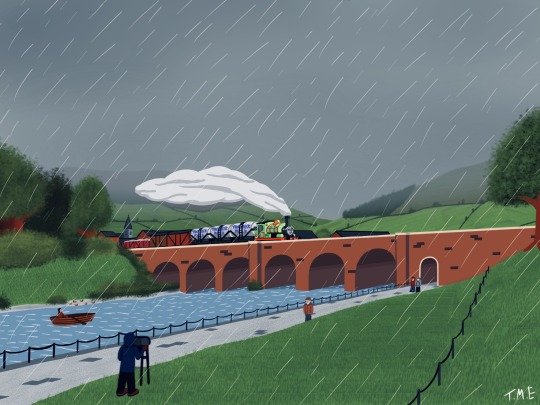
Typical British day for Percy.
#percy the small engine#ttte percy#thomas the tank engine#the railway series#thomas and friends#ttte au#the railway series au#the sudrians#ttte#elsbridge#island of sodor#north western railway
75 notes
·
View notes
Text
Random TTTE head canons and ideas No.1
Henry is a bit of a history buff and also likes to keep up with current events. When there is time his crew will read to him from the newspaper or a book about something he’s interested in. When he’s being prepared for the day or scrubbed down at night he’ll ask to listen to the radio. The only other engine that he can have really in depth conversations about such things is Edward (who gets most of his information from just talking to people).
Although the engines will give Henry a light ribbing for this interest they know it’s important to him and will turn to him for context and an understandable explanation when needed on such subjects.
Although not particularly interested in fiction he has a soft spot for mid century science fiction particularly Doctor Who novelizations. This has led to him calling rude mainland diesels “Daleks” from time to time.
In modern times his current driver has gotten a tablet and will occasionally show Henry videos and play audiobooks on the sort of things that interest him. Though Henry prefers to be read too because in his own words, “It’s just so much nicer to hear a familiar voice do it.”
Henry’s personal recommendations to other engines if they ever want to start being read to are: “ Heroes of History” by Winston Churchill, “The Daleks” by Terry Nations, and “Anything by The Thin Clergyman, of course!” He’ll say with a wink.
#ttte henry#the railway series#henry the green engine#thomas and friends#headcanon#bookworm#thomas the tank engine#ttte edward#just a thought#north western railway#the island of sodor#island of sodor#sodor
7 notes
·
View notes
Text

This year we're celebrating the 79th anniversary of The Railway Series by the Rev. W. Awdry. A series of books that not only connected many people in their childhood, but still does connect them even now that they're adults. My own love and passion for railways and especially steam locomotives wouldn't be the same without the series. Thank you Rev. W. Awdry for all the good memories, all the friends I've made through the series you brought to life.
My drawing from the book "The Eight Famous Engines" is part of the #rwscollab2024 and I am honoured to have taken part in it.
#thomas and friends#james the red engine#ttte#rws#the railway series#the eight famous engines#toby the tram engine#nwr#north western railway#steam locomotive#steam engine#railway#rev w awdry#anniversary#rwscollab2024#taf
6 notes
·
View notes
Text


introducing the big four. the main troublemakers. berwyn (GWR) is probably the only one who still has this photo.
ask box is now open as well !
#inbetweenthelines#ibttl4#lner#lms#southern railway#gwr#great western railway#london midland scottish railway#london north eastern railway#ttte#the railway series#railway series#personification#gijinka#thomas the tank engine#thomas and friends#railway#british rail#oc art#digital art
42 notes
·
View notes
Text

So, here's one of my OCs!
Her name is Monroe (although she usually goes by Turboe) and she works on an island called Lomo.
She is the pilot engine of a busy station in Lomo's capital city and, due to all the trains entering and leaving the station, she has become a very fast shunter (earning her the nickname Turboe)
She's often grumpy and stressed as she almost always has loads of shunting to do, but she's a good engine deep down.
Due to the NWR's engines constantly getting into accidents, they struck up a deal with LOMOR (Lomonian Railways), where LOMOR would send engines to the NWR in order to cover for the NWR's engines while they were repaired. As a result, Turboe (and her brakevan Rudolph) often find themselves on Sodor, doing other engine's work. Turboe is surprised the NWR is even allowed to operate considering there seems to be an accident there every other day, but that's just her personal opinion.
(also I made Turboe like 7 years ago so she's my oldest OC!)

P.S. I've not made an official reference sheet for her yet sorry
#ttte#thomas and friends#thomas the tank engine#trains#ttte oc turboe#ttte oc rudolph#turboe the grumpy engine#lomo#lomonian#lomonian railways#north western railway#nwr#lomor#ttte oc#thomas the tank engine and friends
6 notes
·
View notes
Text
More of Dane's human design! 🖤🚂

I tried to make it look like old paper, as if it was takem from The North Western Railway archives

#ttte humanized#ttte#fanart#thomas the tank engine#art#digital art#illustration#digital artwork#digital drawing#the engine drivers series#ttte 1020#ttte dane#the horrors of hawin lake#sorry for the spam#I just love him#i love tragic stories#and angst#I wanna contribute to the Dane cult#archives#north western railway
24 notes
·
View notes
Text
Since I made many posts on my TTTE OCs from the New York Central and Pennsylvania Railroad, I was recently thinking about expanding my roster of OCs… and these extra OCs would be from the…

Chesapeake & Ohio…
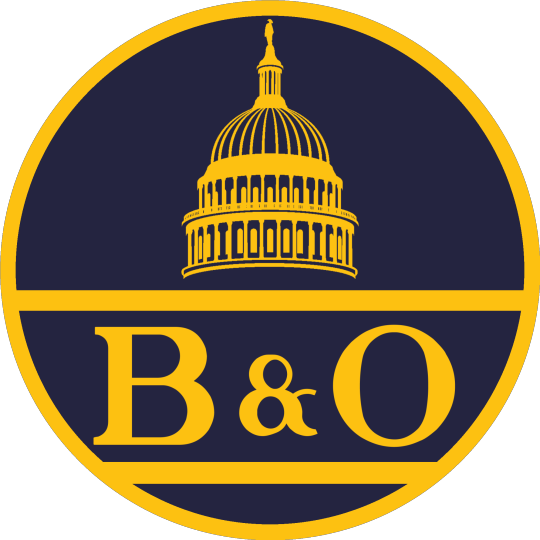
Baltimore & Ohio…

Milwaukee Road…
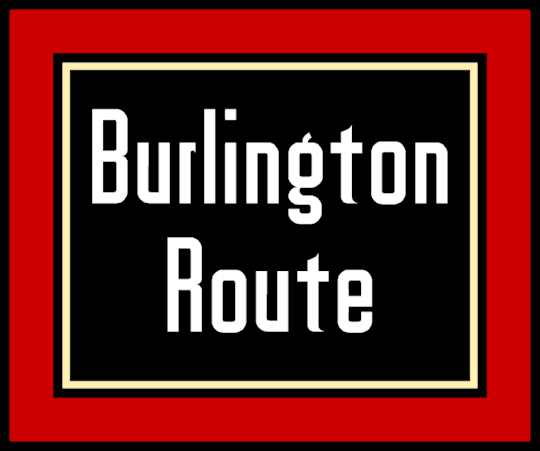
Burlington Route…
and…

Chicago & NorthWestern
Now since this is a recent thought, I haven’t thought about the names of the OCs from these five railroads, let alone what type of locomotives they would be. But don’t worry, when I think of it, I’ll make posts showing and going over them, so stay tuned for that, folks.
#chesapeake & ohio#baltimore & ohio#milwaukee road#burlington route#chicago & north western#thomas the tank engine#thomas and friends#ttte#ttte oc#train#trains#railroad#railroads#railway#railways#the genie team
8 notes
·
View notes
Text
I Made Yet Another ERS Story!
Murdoch the Mighty Engine is now available on Ao3, and will be updated across the weekend. Find it here, and remember to leave kudos and comments!
This particular book is very exciting for me because now I get to start shouting all of my headcanons very loudly because I've uploaded the story version!
#ttte murdoch#i need to calm down#ao3 writer#ao3 fanfic#ao3 author#ao3 link#ao3 stuff#railways#railway series#North Western Railway#nwr#Weirdowithaquill#fanfiction writer#ttte au#thomas the tank engine#i write too much#i write fanfiction
5 notes
·
View notes
Text

NWR Poster 2 - Evening Passenger
Young Nor' Westers - Corelle Hemsworth
Speedpaint
#Young Nor' Westers#art#ttte fanart#artists on tumblr#digital art#ttte#thomas and friends#ttte human oc#North Western Railway Poster#art deco#railway poster#railways#the railway series#rws#thomas the tank engine#ttte henry
123 notes
·
View notes
Text

SO...I just realized something. In the offical rws canon the NWR is under BR until 97...which means for a time Edward was the oldest engine in service with British Railways in the world of RWS Canon
#ttte edward#rws#Hazel acknowledges canons existance for once#North Western Railway#british railways
34 notes
·
View notes
Text
I really love the fact that so many of the engines on the NWR are weird one-offs or have some sort of strange origins.
On any other railway they really would not have lasted very long, but on Sodor, they have a home where they can show everyone just what they can do.
Talking more specifically about The Railway Series, this started unintentionally, it was just that the early NWR had no money and was desperate for any engines they could get. But It grows into just being a part of NWR culture, and how they value personality over practicality.
Like, the NWR keeping steam engines and even saving a few from scrap during modernization is really just an extension of this existing policy: they take in the engines no one else wants and give them a new chance at life. It's something which started with the Three Railway Engines and their stories, and leads all the way to Oliver.
Imagining some new cocksure engine on the NWR saying something like “I’m built different!” and then a more experienced Sudrian engine quickly correcting them bc literally everyone is.
��Welcome to Sodor, mate. We’re all built different. Gordon and James are experimentals, Thomas and Edward don’t even look like the bases they claim they were, fuck knows what Percy even is or where Henry came from, Diesel 10 has an attached hydraulic claw that is probably not approved…”
#reblog#ttte#rws#the north western railway#does this make any sense or am I just rambling?#The NWR and it's absolute mess of a locomotive fleet#Not to mention how so many of the diesels are also from weird and non-standard classes which BR no longer wanted
95 notes
·
View notes
Text
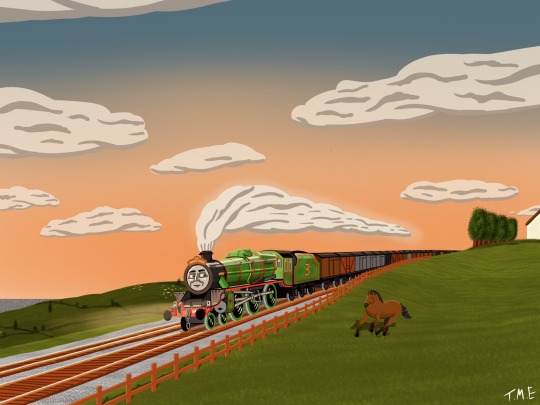
Very early morning run with the Flying Kipper. Back when it all made sense…
#henry the green engine#thomas the tank engine#the railway series#thomas and friends#the railway series au#the sudrians#ttte au#ttte#north western railway#island of Sodor
84 notes
·
View notes
Text

A product of the current hyperfocus on, of all things trains. I was looking through the tags and found humanisations of the ttte trains, and decided that I had to give it a go myself.
Gordon was always my favorite engine, and I've always pictured him as old and proud, so I've tried to reflect it in my design choices while trying to keep all of the key details from his face. I wanted to make it look like Gordon while keeping him in a uniform as well, rather than drawing him in his own shade of blue. I've just given him blue eyes to reflect him being a blue engine, and picked a blue railway uniform.
I did still want to give him his number though, so I just placed it on a small badge on his uniform with another one being for the North Western Railway.
I also really like my word art on this one for his name.
#drawing#tumblr draw#my draws#draw#artists on tumblr#digital art#artwork#art#ttte humanized#ttte gordon#ttte#thomas and friends#thomas the tank engine#gordon#gordon ttte#gordon the big engine#gordon the blue engine#gordon the express engine#gordon thomas the tank engine#fanart#ttte fandom#ttte fanart#my mate is fully convinced that in this universe thomas is gordons child#and i can see it#so i guess ill be drawing thomas at some point soon#50's au
26 notes
·
View notes